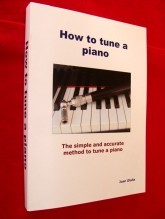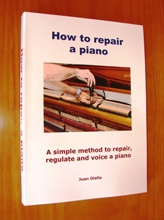Welcome to “How to tune a piano” If you want to tune and repair your own
piano, congratulations, you have arrived to the right place. Here we offer you for free the best and most useful information.
 This is an easy and friendly online guide to tune and repair pianos, one step at a time. In this tutorial you will learn the basic steps to tune the professional way, the standard procedure and the equipment and tools you will need.
This is an easy and friendly online guide to tune and repair pianos, one step at a time. In this tutorial you will learn the basic steps to tune the professional way, the standard procedure and the equipment and tools you will need.
About this tuning guide “tuning my own piano”
First of all, tuning a piano required some basic tools. These you can buy at any online tool suppliers on the internet. You could buy everything as a piano tuning kit or you can buy them individually. What ever way you choose, make sure you buy the right thing. If possible try to buy good quality piano tuning equipment, that way you will have better overage results and your tuning will be easier and more accurate.
Piano tuning tools
A set of basic piano tools is not too expensive, certainly no more than a standard professional tuning.The first thing you obviously need to learn to tune pianos, is a piano in a reasonable good state. Bear in mind that some very old ones specially if they still have wooden frames are simply not tunable, so better disregard those ones as they will make the tuning very difficult or practically impossible. The piano can be old but must hold the tune, that means it must be in a good enough condition to stand a standard A-440 tune and hold it for some time. Also better to choose a good size one. Big uprights and grands are easier to tune than spinets and small uprights.
The tuning lever or hammer
A whole chapter could be writing about the tuning hammer, this is the most important piano tuning tool. I think you could consider to buy a good one, no doubt it’s a good investment. The extended ones with changeable heads and tips are the best ones. A good tuning lever is far better than an ordinary one, makes the job easier, more precise and professional.
The tuning fork and two rubber mutes
An ordinary tuning fork A-440. You can buy them at any musical instrument shop. The tuning fork produce an exact pitch that you will use as a basic reference. The rubber wedges you can buy or make then yourself. The utility of these simple rubber wedges is to mute the strings we don’t want to hear.
Felt temperament strip
Better to have a couple of these. They are strips of felt about two or three millimetres thick by two or three cm (one inch) wide and about a meter long. We will need then to set the temperament which is the first thing we do when tuning a piano.
A metronome
Any metronome will do, but one of those small digital ones would be perfect. A metronome will be very handy in early learning so that we can practice and check the accuracy of the beat rates we use when tuning a piano. When we are accustomed to hearing and recognizing the beat rates, then will not need the metronome anymore. The beat rates that we use for tuning (thirds and sixths interval method) are 7, 8 and 9 bps.
To learn how to judge beat rates by using a metronome follow this procedure:
Set the metronome to 105 mm (ticks per minute) and count 4 beats per tick, then you will be counting 7 bps (105 x 4 = 420) (420 : 60 = 7)
Set the metronome to 120 mm and also count 4 beats per tick, that is 8 bps
Set the metronome to 136 mm and count 4 beats per tick, that is 9 bps
For practicing, stop the metronome and try to keep the beat going in your head. This will give you a good idea of the different beats we use for tuning.
TUNING PROCEDURE
Disclaimer: What follows is a basic and general information procedure for tuning a piano. To view the full protocol and specific piano tuning instructions, please refer to ebook
The temperament
The temperament could be defined as a group of notes in the center of the keyboard, stretching approximately one octave (normally from F33 to F45 or from F33 to A49) that are tuned in a certain way. Once the temperament is set we will use it as a reference to tune the rest of the keyboard. Setting the temperament is the most important aspect of tuning. The quality of our piano tuning depends a great deal on how well the temperament has been built. Although setting the temperament is not really complex, its study required some time and practice. Time well spent I would say, as once learned, you can apply to every tuning you will make in future.
Basically there are two groups of temperaments. In one hand the ones that use mainly fifth and fourth intervals and only third and sixth intervals for testing. The other group of intervals on the contrary utilizes mainly third and sixth and only fifth and fourth to check and evaluate. In my humble opinion, the second group is better. Why? Because the third and sixth intervals produce faster beat rates, about 7, 8 and 9 bps (beats per second), generally easier to listen and judge. In contrast, the first temperament group, the one that uses mainly fifth and fourth intervals, generates slower beat rates, which for most of us are significantly harder to recognize.
SETTING THE TEMPERAMENT
First step
Mute the unisons Mute with a felt strip the side strings of every unison from F33 to F45 (see the picture above). Leave unmuted the center strings as this will be for now the only string of every unison in the temperament that we will tune.
Second step
Using the tuning fork Tune A4 to its theoretical standard pitch 440 htz. You will need a chromatic tuner with speakers that can generate that frequency or an A-440 tuning fork.
Third step
Tuning the temperament. Now tune the temperament. The standard way to tune the temperament is using third, sixth and fifth intervals and tuning them to specific beat rates, save fifth and fourth interval for testing. If you prefer or feel more confortable, you can do the other way around as there is not rule of thumb in this matter. At this stage, the center string is the only string at every unisons in the temperament that you will tune.
Forth step
Tuning octaves. Tuning octaves is fairly simple. Tuning hammer on F#46 (mute the side strings with a couple of rubber wedges). Strike at the same time F#34 (already tune) and F#46. Tune till you eliminate all audible beats and the two notes sound as a single one. Then tune G47 in the same way and carry on tuning every note towards the upper end of the keyboard. When tuning the bass section apply the same procedure.
Fifth step
General review Review and test what you have just done so far. Take special attention to the unisons as they are the ones that first go “out of tune”. Try to eliminate all the audible beats or at least get them as beatless as possible. A good hammer skill would be handy at doing so.
DOING THE “STRETCH”
It’s a matter of fact that a piano sounds better when its upper section and low section are stretch. That means that the high notes (more or less the last two octaves) are tuned sharper than theoretically they should, and the very low notes tuned lower than they also should be. You could ask, why is that? The reason is that a piano tuned in that way simply sounds better. That is commonly accepted, so an experience technician should do what is called “the stretch”.
The “stretch” is tuned exponentially, that means that the stretching becomes more and more pronounced as you advance up the keyboard There are theoretical tables that allegedly determined the amount of “stretch” for every key, but that’s all. In this matter like in many others involving piano tuning there is not rule of thumb, and in reality every tuner do the “stretch” at his/her discretion. I think, to be precise, when in the lower notes the stretch shouldn’t be call that way, but the “shrink”, as that’s what really happens, but that’s just my point of view.
To do the “stretch” you need some practice and experience. If you are newbie to piano tuning I don’t recommend you try doing the stretch, at least not for now. Just wait some time till you are reasonably proficient.
copyright © Juan Olalla 2010
Has this tutorial been helpful to you? Any question or advice? You are welcome to leave a reply. Your opinion and/or suggestions are highly appreciated. Thanks







Hi John,
My excuses, I admit a tutorial should be needed to explain how to judge beat rates by using a metronome, I will do that as soon as possible, but for the time being let me give you a few instructions. The beat rates that we use for tuning (thirds and sixths interval method) are 7, 8 and 9 bps.
Set the metronome to 105 MM (ticks per minute) and count 4 beats per tick, then you will be counting 7 bps (105 x 4 = 420) (420 : 60 = 7)
Set the metronme to 120 MM and also count 4 beats per tick, that is 8 bps
Set the metronome to 136 MM and count 4 beats per tick, that is 9 bps
For practicing stop the metronome and try to keep the beat going in your head. This will give you a good idea of the beats we use for tuning.
As soon as time allows it I will make available a mp3 file with the recording of the diferent beats, I think that will also help.
Regards,
Juan
Hi Juan,
I recently purchased a vertical piano and last Tuesday had its first warranty tuning. To my surprise, the technician pulled out an iPhone with the tune lab tuner application and started tuning the strings from the lower A to the last C!!
I say surprised because I have seen many Piano tuning before, where the central octave is tuned and the others thereafter; no tuning of unisons, no intervals played; After the technician left, I started playing the piano again and it kind of hurtful to listen to it.
Any suggestions?
Luis
Hi Luis,
I do not know who tuned your piano but it doesn’t look very professional tuning a piano with a smartphone app. If it does not sound good then the piano tuning is not good. I suggest that you call the dealer who sold you the piano and complain about the quality of the tuning, ask then to send you a competent technician.
Regards,
Juan
Luis,
There’s nothing unprofessional about using a smartphone app. What matters in tuning the piano well depends on:
1. the experience and care taken by the tuner. Many people can charge money, and have the most advanced equipment, but that doesn’t mean he or she knows or cares what they’re doing.
For example, it’s possible to tune a piano well, but not set the pins correctly. At the first hard strike, the note will drop in tune. It’s possible that the tuner didn’t bother to check his work, and that some notes moved. Perhaps he had another tuning and was in a rush to get out the door.
2. The piano. Small pianos, especially in lower price ranges, are notoriously hard to tune. The short strings mean that compromises have to be made. I have a Yamaha U1, one of the most popular pianos in the world—it still has problems with inharmonicity and false beats. The weather in your area will also play a part.
3. The software. About half of all techs are said to use tuning software for many reasons, including speed and accuracy, and preservation of hearing. The top machines used to be stand-alone units, but that is no longer the case. Now the best tuning software is made for smart phones and tablets. What it’s on doesn’t really matter. What does matter is the sophistication of that software. I use the Veritune for iPhone, which costs $600. Some of the programs can cost $1000. This is very sophisticated software that listens to all the partials for each note, and calculates how the piano as a whole will be tuned to itself. It’s much more sensitive than the human ear, and will even remember the specific tuning for every piano you tune.
If the tuner used a free app, then that is a different matter. There is no one “correct” tuning for all pianos–each one is different and has to be tuned to ITSELF.
So I wouldn’t discount a tuner because they use a smartphone it. There are too many other variables.
Hi Carlos,
Any tuning lever (they also call it tuning hammer) with a standard number #2 tip will work alright for your piano. This tuning hammmer you can buy at any piano tools supply.
Regards,
Juan Olalla
Hi Juan,
Aural tuning is definitely a very difficult undertaking to learn without a qualified trainer supervising until good tuning hammer technique and some idea of what to do and what is listened for is established. I’m not saying it’s not impossible to learn how to tune otherwise…but one of the biggest obstacles to learning tuning is learning good tuning hammer (lever) technique. That entails starting to hear what’s going on with the string as you are moving it around with the tuning lever, and learning to move the hammer and string in very small controlled increments. First, when you move a string, it is usually best to move it a tiny bit flat…this does a couple of things. First, you ensure you’re on the right tuning pin for that string! Second, it “loosens” the string on its termination points and breaks it free before you go the opposite direction to bring it up to pitch. Now, for pianos, you “overshoot” and go a tiny bit sharp of pitch, then, gently lower it down to pitch. Other instruments like harpsichord, guitar, etc., you just bring the string just up to pitch. In piano, there is a lot going on because it is a high string tension instrument. String tension has to equalize from tuning pin to agraffe or de capo bar to speaking length to bridge to hitch pin. In short, it works better if you go very slightly sharp, then ease it down into pitch.
Understanding temperament is another whole issue and what things are supposed to happen there. The way major thirds and sixes, and 10ths, beat very fast (they are tuned “wide”–I can’t write a book here so can’t fully explain) fourths and fifths are almost clean and beatless–and all these, progressively beat slightly faster as you go up the piano, slower as you go down. Octaves, you tune them beatless but ever so slightly sharp going up the scale to introduce stretch which compensates for higher notes on the piano sounding flat to our ears. Of course, you can circumvent the whole issue of temperament and use an electronic tuning aid….with the understanding that how far a piano is from regulation pitch–440, determines various degree of overshooting and having to tune a piano twice or even three times to stabilize it if it is either far sharp or flat from where it should be.
Beginners–find someone who will work with you and teach you if you can. It is definitely an art learning all this.
Hello Ed,
I get your point and partly I agree with it, but please let me say that the objective of a book like “How to tune a piano” is not to make a professional piano tuner just by reading the book (that would be insane), but to provide the basic-intermediate knowledge and right directions to anybody interested in piano tuning.
We all know that to be a pro tuner takes years of work and experience, but I also think about the ordinary piano owner who wants to tune (or at least to better) his own piano, this guy has all the time (no customer behind to worry about) and can compensate his lack of expertise by putting more time into it.
About “screwing up” the piano, the most common mistake students make is the odd broken string, which if you look at it on the bright side is an excellent opportunity to learn how to replace broken strings, by the way, full instructions for doing so are contained in my second book “How to repair a piano”.
In whole, this book does not promise you the moon nor will perform a miracle, but it will no doubt be a good asset to any serious and motivated person who just wants to learn how to tune pianos.
Hasta la vista amigo,
Juan Olalla